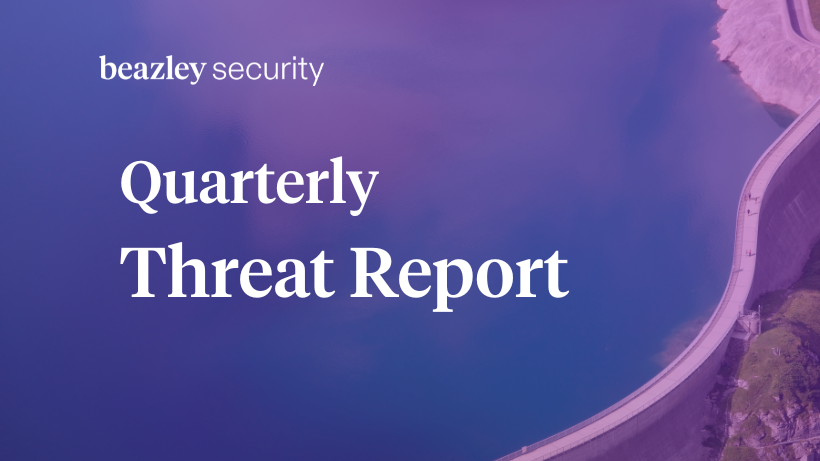Top Five Predicted Cyber Threats for 2025
What should you be watching out for in the coming months? Here are the cybercriminal tactics you should be preparing for in 2025.
As we look toward 2025, businesses must brace for a rapidly evolving cyber threat landscape. With cybercriminals becoming more sophisticated, preemptive strategies are crucial to safeguard assets and maintain a robust cybersecurity posture. In our recent Top Threats for 2025 webinar—conducted in the US, UK, France, and Germany--experts from Beazley Security highlighted the top five predicted cyber threats businesses need to prepare for:

1. Exploitation of Zero-Day Vulnerabilities
Zero-day vulnerabilities remain a significant risk in 2025, especially for edge devices such as VPNs and firewalls. These devices, which are inherently internet-exposed, make inviting targets due to their access to network perimeters. The rapid pace at which these vulnerabilities are now exploited is alarming. Historically taking weeks or days, cybercriminals can now weaponize these vulnerabilities within hours of discovery, increasing the urgency for businesses to prioritize patch management and enhance monitoring to detect unauthorized access.
.svg)

2. Advanced Social Engineering Attacks
We expect to see a surge in sophisticated social engineering attacks driven by the abundance of leaked personal data. Cybercriminals are crafting hyper-targeted phishing campaigns to deceive individuals by leveraging personal and professional information. In 2025, attackers could use AI to generate highly personalized lures, bypassing traditional security controls. These lures could impersonate colleagues or bosses, urging recipients to share sensitive information or authorize fraudulent financial transactions, necessitating robust user-awareness programs.
.svg)

3. Use of Deepfakes for Misinformation and Cyber Extortion
Deepfake technology, powered by AI, is becoming a more formidable tool in the cybercriminal arsenal. These counterfeit video and audio recordings mimic trusted figures, creating realistic impersonations that can be used for fraud or weaponized false narratives. For instance, attackers could use a deepfake video of a CEO to authorize a financial transfer or disclose proprietary information. As this technology becomes more accessible, businesses must implement multi-layered verification processes and be suspicious of unexpected requests, even from known sources.
.svg)

4. Increase in Supply Chain Attacks
The complexity and interconnectivity of supply chains create vulnerabilities that cybercriminals are eager to exploit. In 2025, supply chain attacks will continue to grow as attackers target critical suppliers to gain access to multiple organizations simultaneously. This method not only amplifies the impact of a breach but also challenges organizations to secure not just their infrastructure but also that of their partners. Establishing stringent supplier security controls and conducting regular audits can mitigate these risks significantly.
.svg)

5. AI-Driven Automated Attacks
With AI technology evolving, we anticipate a rise in automated cyber-attacks. Lower-skilled hackers are now equipped with generative AI tools to automate various attack vectors. These can include building simple exploit scripts and conducting wide-scale reconnaissance to identify vulnerabilities or misconfigurations. This automation enables quick exploitation with minimal effort, making traditional defenses less effective. Businesses should invest in AI-driven security solutions of their own, enhancing their ability to detect and respond to these AI-led threats effectively.
.svg)
The cyber threats poised for 2025 will require organizations to adopt a cohesive, proactive cybersecurity strategy. Implementing layered defenses, enhancing user awareness, investing in AI-based security solutions, and fostering strong partnerships with suppliers will be critical in mitigating the risks posed by these emerging threats. As cybercriminals continue to innovate, so must our defenses evolve to stay one step ahead.
As we look toward 2025, businesses must brace for a rapidly evolving cyber threat landscape. With cybercriminals becoming more sophisticated, preemptive strategies are crucial to safeguard assets and maintain a robust cybersecurity posture. In our recent Top Threats for 2025 webinar—conducted in the US, UK, France, and Germany--experts from Beazley Security highlighted the top five predicted cyber threats businesses need to prepare for:

1. Exploitation of Zero-Day Vulnerabilities
Zero-day vulnerabilities remain a significant risk in 2025, especially for edge devices such as VPNs and firewalls. These devices, which are inherently internet-exposed, make inviting targets due to their access to network perimeters. The rapid pace at which these vulnerabilities are now exploited is alarming. Historically taking weeks or days, cybercriminals can now weaponize these vulnerabilities within hours of discovery, increasing the urgency for businesses to prioritize patch management and enhance monitoring to detect unauthorized access.
.svg)

2. Advanced Social Engineering Attacks
We expect to see a surge in sophisticated social engineering attacks driven by the abundance of leaked personal data. Cybercriminals are crafting hyper-targeted phishing campaigns to deceive individuals by leveraging personal and professional information. In 2025, attackers could use AI to generate highly personalized lures, bypassing traditional security controls. These lures could impersonate colleagues or bosses, urging recipients to share sensitive information or authorize fraudulent financial transactions, necessitating robust user-awareness programs.
.svg)

3. Use of Deepfakes for Misinformation and Cyber Extortion
Deepfake technology, powered by AI, is becoming a more formidable tool in the cybercriminal arsenal. These counterfeit video and audio recordings mimic trusted figures, creating realistic impersonations that can be used for fraud or weaponized false narratives. For instance, attackers could use a deepfake video of a CEO to authorize a financial transfer or disclose proprietary information. As this technology becomes more accessible, businesses must implement multi-layered verification processes and be suspicious of unexpected requests, even from known sources.
.svg)

4. Increase in Supply Chain Attacks
The complexity and interconnectivity of supply chains create vulnerabilities that cybercriminals are eager to exploit. In 2025, supply chain attacks will continue to grow as attackers target critical suppliers to gain access to multiple organizations simultaneously. This method not only amplifies the impact of a breach but also challenges organizations to secure not just their infrastructure but also that of their partners. Establishing stringent supplier security controls and conducting regular audits can mitigate these risks significantly.
.svg)

5. AI-Driven Automated Attacks
With AI technology evolving, we anticipate a rise in automated cyber-attacks. Lower-skilled hackers are now equipped with generative AI tools to automate various attack vectors. These can include building simple exploit scripts and conducting wide-scale reconnaissance to identify vulnerabilities or misconfigurations. This automation enables quick exploitation with minimal effort, making traditional defenses less effective. Businesses should invest in AI-driven security solutions of their own, enhancing their ability to detect and respond to these AI-led threats effectively.
.svg)
The cyber threats poised for 2025 will require organizations to adopt a cohesive, proactive cybersecurity strategy. Implementing layered defenses, enhancing user awareness, investing in AI-based security solutions, and fostering strong partnerships with suppliers will be critical in mitigating the risks posed by these emerging threats. As cybercriminals continue to innovate, so must our defenses evolve to stay one step ahead.
Learn more
.jpg)
For more on the critical cybersecurity controls you should be using and how they can protect your organization, replay the webinar on demand at:
Top Threats for 2025 (Webinar Replay)
More Insights
View All >Beazley Security can help protect you
We offer services and solutions to help you prepare and stay resilient in the changing threat landscape. Prepare to learn more about how we can help you










